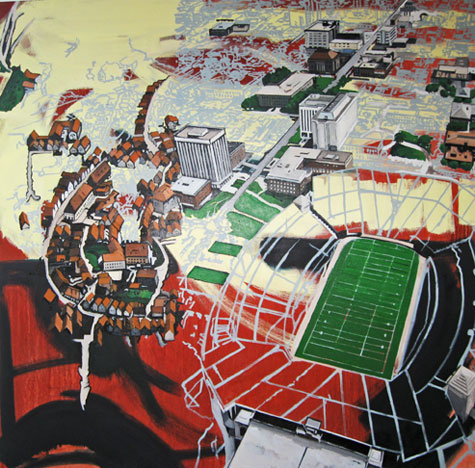
CONSTANTLY MORPHING "Mind the Gap," oil on canvas, by Molly Levine, 2009.
|
The five artists featured in "Stratum," now on view at Whitney Art Works, are diverse in background, medium, and scale, but they comfortably crowd the gallery's two rooms with sculptures, paintings, and drawings that respond to the relationships exposed by stripping back layers and how meaning and interpretation shift when new layers are presented. The wide range of approaches featured asks us to consider the structures inherent in our landscape, society, memory, history, and identity.

Michael McFalls's geological cross-section, "Geoform 6.8 (Unfettered Growth 2)" confuses the barrier between organic and artificial, and most literally exemplifies the theme of the show. Reminiscent of Roxy Paine's Scumak polyethylene blobs, McFalls's bust-like sculptures illustrate the concurrence and symbiosis of composition and decomposition. Erratic limbs of multi-tonal steel emerge from a cake of layered pigmented plaster, while real branches form a skeleton for a glossy ooze that drips into stalactites. The evolution of organic branch to crimson steel shows the derivation of the synthetic from the natural, with clearly delineated layers evincing time, mutation, and progress. These sculptures serve as archaeological relics of a transition from log cabin to pre-fab.
In the confident oil paintings that backdrop McFalls's sculptures, Molly Levine, a recent Maine College of Art graduate, responds to the levels of architectural structures within our urban landscapes. In "Mind the Gap," an initial rust-orange wash dominates the canvas, and each layer painted over it remains apparent; accidental drips and splashes archive process. She builds on the wash with abstract expressionistic quick black brushstrokes (mimicking the emotional and historical underpinnings of any urban space), and then a consistent and illustrative gray line that maps out a blueprint of a city. The final layers of the painting define houses, city centers, and lawns, but sparingly so; the articulation dissipates as the city expands. The painting reads as sketchy or unfinished, like our social spaces, which are constantly morphing to accommodate our technological progress and increasing population. Previous layers of paint and architecture are incorporated into new ones, or are completely concealed by advancements.
Jaime Gili's explosive acrylic paintings complement Levine's work in palette, using active contrasts to push and pull Malevich-like splintered forms. Gili, born in Venezuela and now working in London, is the artist whose work is slated to decorate 16 Sprague Energy oil tanks in South Portland. His tank design mirrors the three vibrant paintings featured in "Stratum," which are a highlight of the show. Gili layers not only shapes, but also artistic approaches, including futurism, minimalism, and street art.
Gili's amalgamation of modern influence results in a cohesive contemporary style, but Elianna Mesaikos's fastidious ink on paper menageries present a hierarchy of more frivolous references. Mesaikos, another MECA alumna, evokes Rococo and Victorian ornateness to build decadent coats of arms, crowns, and wallpaper from a satirical circus of personified animals parading around decorative pearls, flowers and polka dots. The irony and naiveté inherent in these pieces may be an obvious subscription to a (possibly) played-out contemporary aesthetic, but Mesaikos's masterful draftsmanship and ambitious scale make these works impressive.
Perhaps the most provocative and considered work in the show, Diana Cherbuliez's sculptures beg for intimate engagement, to appreciate the meticulousness of a dental-floss bridge hand-woven in a Victorian style, or to notice the infinite perspectives made available when peeking inside the mirrored works. Very attentive to detail, Cherbuliez uses salvaged materials from construction sites she works on in Vinalhaven, adding elements of historical and sentimental value. "Bedroom Wallpaper" is a medicine-cabinet-like box built from baseboard molding and wallpapered with antique paper. Inside is a helix intricately carved from a single piece of beech that is contained by mirrors. As you gaze further into the work, the helix forms new helixes with its reflection, and your reflection enters the composition. Cherbuliez presents a canvas for personal meditation, the helix a representation of our inner makeup, and our perspective of it as unique as the multi-faceted identity we subjectively bring to the work when we experience it.
Annie Larmon can be reached at aglarmon@gmail.com.
"STRATUM" | works by Michael McFalls + Jaime Gili + Diana Cherbuliez + Molly Levine + Elianna Mesaikos | through May 30 | at Whitney Art Works, 492 Congress St, Portland | 207.774.7011